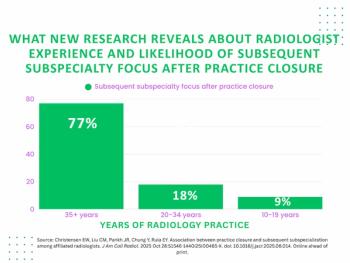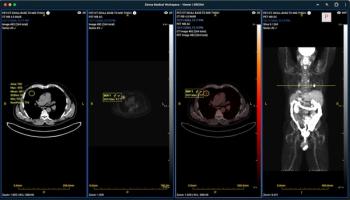
Addressing the Radiological Taffy Pull: Suggestions for Communicating Worklist Priorities
In order to alleviate some of the challenges with radiology worklist overload, this radiologist suggests alternative approaches for conveying new imaging requests and priorities.
The hardworking radiologist began his weekend shift. As usual, the day began with a long list of cases from overnight that needed to be read out. If history was any indication, the cases would take the radiologist through at least mid-morning.
Whenever he felt like he was making good progress, new cases came in from the ER or there were new ones for inpatients. It didn't matter where the cases were coming from, they were all considered STAT, just like every one of the cases from the night before.
Not that there was ever any respite from those but since he was the only rad "on," he was also the go-to guy for any clinician with radiological issues. This could involve clarification on what other rads had reported, requests for prioritized reads on "routine" cases done during the preceding week, second opinions about scans from other facilities, you name it. There were also calls for any rad tech asking about protocols and the proverbial "Can you look at this case for a second?"
Each new "drop everything else and pay attention to this now" interruption pushed back the time at which the rad might hope to get everything done. If more poetically inclined, he might have likened it to submersion in slow-rising floodwaters, creeping up his neck to threaten his mouth and nose.
Along came a department clerk with a list of a dozen older cases that had slipped through the cracks, and now needed a read. "Whenever you get a chance,” said the clerk.
What didn't happen: The radiologist, now asked to do 120 percent of what was humanly capable instead of 110 percent, morphed into a demigod on the spot, and handily took care of it all before anybody could ring him up again to ask why he hadn't done X, Y, or Z yet.
What also didn't happen but was a little closer to reality: The rad's head exploded, and custodial services were paged STAT to clean up the mess before a backup rad might show up to take over the workstation.
Any rads reading this who have never experienced such circumstances are either new to the job, or exceptionally fortunate in the sort of workplaces they have inhabited. Maybe their case volumes and staffing have been more kindly proportioned, or perhaps they have dwelled within great infrastructures.
I consider that last one most important, in part because rads are likeliest to have a say in it and, sometimes, even control. It could also be argued that the most efficient setup for a radiology practice is to have the rads at near 100 percent capacity. Maybe leave a percentage point or three of slack to allow for crises, but otherwise you're buying rad relaxation at the cost of wasted manpower.
Whatever the capacity of your rads is, putting them in an infrastructure that is "less than" will diminish it, effectively bringing the near 100 percent they had been expected to handle to now over 100 percent. Alternatively, however good you think your infrastructure is, if you find ways to improve it, your rads might wind up doing more than you ever thought realistic or possible.
Pulling rads in different directions like highly educated pieces of taffy doesn't magically make them do more or better work but it does stress and demoralize them. Why not adjust your infrastructure so this doesn't happen or, at least, happens less?
Some places have figured this out more than others. The handful of rad groups I have been a part of ranged from lousy to middling good in this regard so I have had some opportunity to see what works and ample opportunity to wish for other things that would work better.
Intelligent worklists could take away a lot of the sense of being an air-traffic controller, and some places have them. If a rad already has more than a few things on his or her plate, why waste the rad’s time by interrupting him or her to say that you're adding something, especially if it doesn't take priority over the existing cases on the worklist. Just add it to the rad’s worklist from your own terminal and weight its urgency so it gets its an appropriate place in line.
If you don't have such sophisticated gear, you have to make up for it with intelligent and efficient human behavior. Some of that is going to vary with the rad in question. The best thing you can do is ask the rad what he or she would prefer. If the rad doesn’t know what he or she would refer, bring it up again down the line. Either your routine works well for the rad, or he or she will have developed some ideas about how it could be changed to improve efficiency (and probably the rad’s morale).
For me, I would suggest a simple guideline. If you are thinking of bringing me a task, but I am already doing other things that are at least as important as it is, don't bring it to me now. Interrupting what I'm doing won't get it done any faster, but it will make me feel pressured. Further, if I'm already feeling overburdened, don't give me an opportunity to seem unpleasant and "shoot the messenger" who is piling that burden even higher.
Sure, somebody needs to keep tabs on the fact that case X needs to be read. But don't just dump it on me so, in addition to reading the dozen STAT cases I already have plus whatever else comes in, I now have to remember that case X is waiting in the wings. Let the ancillary staff that wants to tell me about case X hold the thought until I (or another rad) can possibly do something about it.
I would prefer a notification system that gets my attention when I have completed my current batch of cases. Maybe it is something that prevents me from grabbing a new batch, or a pop-up window saying "rad clerk has a message for you" after I do the last of the current group on the worklist. Otherwise, perhaps just make it a known thing that, at least once per half-hour, I will reach out to a designated member of staff and ask: Got anything for me? By the time I get to it, perhaps the clerk will give me two or three accumulated tasks at once rather than a "slow drip" of multiple separate requests.
In addition to minimizing unnecessary interruptions to my workflow, this gives me a little built-in break from it. This is better than the homogeneous blur of reading a bunch of cases and then just reaching for another batch. Even if it is just talking to ancillary staff about some other work they have for me, the interaction comes in a way that is helpful and refreshing.
Newsletter
Stay at the forefront of radiology with the Diagnostic Imaging newsletter, delivering the latest news, clinical insights, and imaging advancements for today’s radiologists.
































